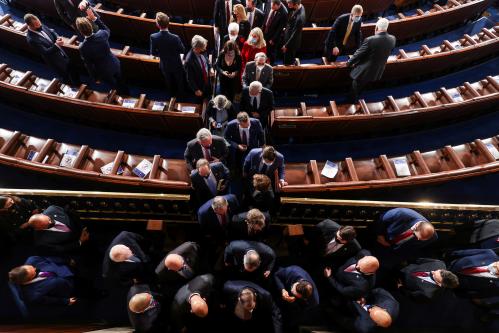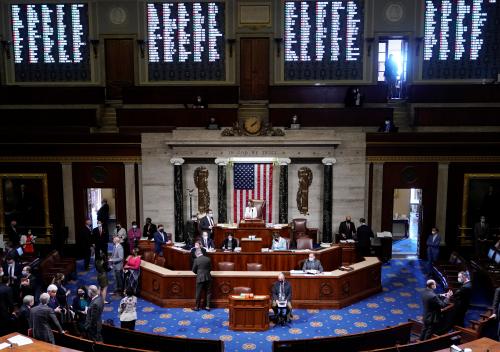On Monday, the Senate advanced a bill to keep funding federal operations through mid-December—a key step towards keeping the government open when the calendar turns to the new fiscal year on Saturday. A shutdown may be unlikely, but this round of fiscal brinkmanship still reminds us of a few important facts about the contemporary appropriations process.
- Not all “shutdowns” are created equal
Even if Congress and the president had failed to act by Friday night’s deadline, the most likely result would have been a short “lapse in appropriations” rather than a true “shutdown.” The former tend to last somewhere from a few hours, like in February 2018, to a few days or a weekend, as in January 2018. These shorter episodes are sometimes the result of a single senator or small group of senators refusing to agree to waive some of the chamber’s timing rules, a move that requires at least the implicit consent of 100 senators. While even a temporary lapse is disruptive, it is the longer true shutdowns that have far-reaching consequences for federal agencies and the Americans who rely on their operations.
- For a shutdown to last, someone has to want it
True shutdowns happen, in the words of Bloomberg’s Jonathan Bernstein, “not because of bargaining impasses, but because one side actively chooses them.” In the case of the record length partial shutdown in late 2018 and early 2019, for example, it was President Trump making this active choice, believing that a shutdown would strengthen his hand in his efforts to secure funding for a wall along the southwestern border. In 2013, meanwhile, the underlying goal of a 16-day shutdown was to delay, if not defund, President Obama’s signature health care law.
This year, it doesn’t appear that either party in either chamber—or President Biden—actively wanted to fully shutdown the government. The midterm elections are just weeks away, and members don’t want to be blamed for disruption in their constituents’ lives just before they head to the ballot box.
- Watch the cars, not just the locomotive
The key to unlocking progress this week on a temporary spending bill, called a continuing resolution (CR), to keep the government open was the removal from the package of the Energy Independence and Security Act of 2022, a proposal authored by Sen. Joe Manchin (D-W.Va.) to reform aspects of the permitting process for energy and minerals projects. In the current legislative environment, CRs have become attractive vehicles for carrying other measures across the finish line; the CR is the locomotive at the front of the train, but it is often pulling other cars with it out of the station.
Determining which “cars” will make up the “train” is a delicate task. On one hand, the must-pass status of the CR makes it an attractive way to adopt provisions that might have trouble passing on their own, and, in some cases, attaching an item might help build the necessary coalition to pass the overall package. But at the same time, if the inclusion of a particular proposal threatens the underlying bill’s prospects—as Manchin’s did–it’s likely to get left behind.
While Manchin’s now decouple “car” got the most attention, there are a number of other provisions lined up to be attached—including additional funding for aid to Ukraine and a short-term extension of the authorization for the National Flood Insurance Program.
- Shutdowns avoided aren’t shutdowns without consequence
Even when Congress and the president manage to avoid a true shutdown, the brinkmanship has consequences. When a possible shutdown is on the horizon, agencies engage in detailed planning for how to wind down their affected operations. In the case of short lapses in appropriations, like in 2018, they may need to begin to put these plans into action—only to have to promptly reverse them when Congress and the president act. Time spent by agency officials engaging in this preparation is time spent not fulfilling other responsibilities.
Beyond using resources to plan specifically for shutdowns, the reliance on short-term continuing resolutions to avoid them is also costly. As work by the Government Accountability Office has documented, temporary spending bills cause delays in certain government activities and repetition in others. What’s more, when a continuing resolution is followed by the adoption of a regular appropriations bill mid-way through a fiscal year already in progress, agencies are left with less time to spend responsibly the funds allocated to them.
Even with passage likely before the end of the week, the current CR under consideration will expire in December, necessitating more action before the holidays. Congress has struggled repeatedly to avoid budget brinkmanship and absent changes to the broader political environment that would incentivize different behavior, we are likely to find ourselves back in this same spot again.







Commentary
Shutdown politics—understanding fiscal brinkmanship
September 28, 2022